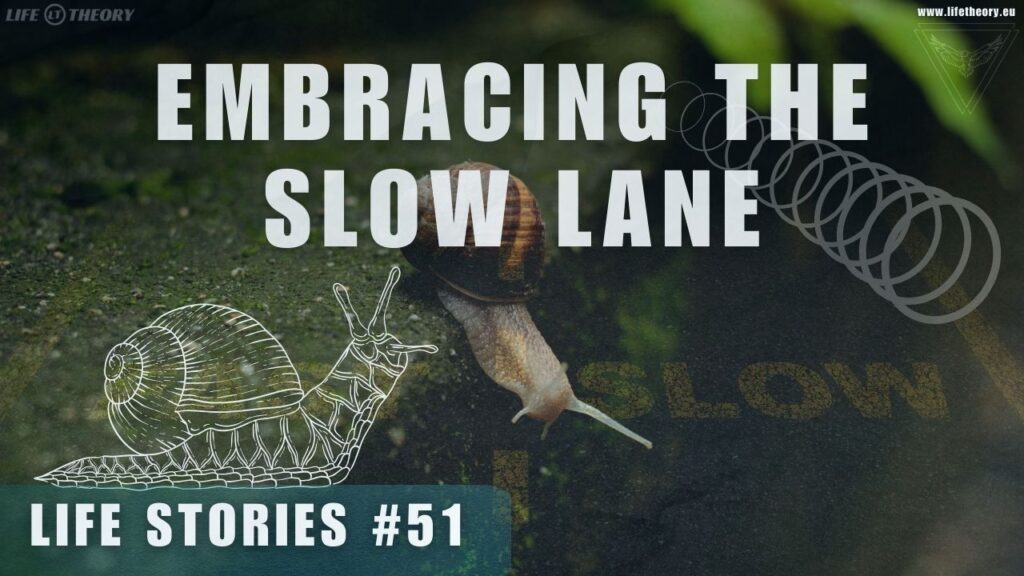“Embracing the Slow Lane: The Art of Mindful Living in a Fast-Paced World” – Life Stories 51
Mindful Living in a Fast-Paced World!
Welcome to a transformative exploration of slow living in a world obsessed with speed. Join us as we uncover the profound benefits of intentional living and discover how slowing down nurtures body, mind, and soul.
The Art of Mindful Living in a Fast-Paced World
Subtitle: Discovering the Power of Intersectionality: How Slowing Down Nurtures Body, Mind, and Soul
In an era where the tempo of life seems to be set at a perpetual fast-forward, there exists an almost radical proposition: the idea of slowing down. We live in a world enamored with speed and efficiency, where every moment is measured not in its intrinsic value but in its capacity for productivity and rapid progression. Yet, amidst this whirlwind of ceaseless motion, a counter-movement whispers a different truth – the art of living slowly.
Imagine for a moment a world where the first rays of the sun aren’t a starting gun for the race of the day, but a gentle invitation to awaken with grace. Where mornings are not a frantic dash but a time for reflection and intention. This is not a distant utopia, but a choice available to each one of us – the choice to prioritize mindfulness over haste, quality over quantity.
The concept of living slowly isn’t about rejecting modern advancements or retreating from society. Rather, it’s about establishing a harmonious balance between our external demands and our inner needs. It’s an acknowledgment that in the constant pursuit of ‘more’ and ‘faster,’ we often lose sight of the essence of our existence.
Consider the way we eat – fast food, a symbol of our times, designed for speed and convenience, often at the cost of nutritional value and culinary pleasure. Or fashion, where trends change in the blink of an eye, promoting a cycle of endless consumption that rarely pauses to appreciate the beauty and craftsmanship of a well-made garment. This rhythm of rush pervades every aspect of our lives, from how we work to how we relax, creating an illusion that life is a race to be won, rather than a journey to be savored.
In this narrative, slowing down becomes an act of rebellion, a deliberate choice to swim against the current of acceleration. It’s a commitment to becoming more mindful and intentional, to understanding that the quality of our lives is not determined by how much we can squeeze into each day, but by the depth and richness of our experiences. Slowing down is about learning to listen – to our bodies, our minds, and our hearts – and responding to their needs with care and thoughtfulness.
As we embark on this journey of deceleration, we discover a paradoxical truth: by slowing down, we actually enhance our ability to live fully and deeply. It’s in the pauses between the busy moments that we find clarity, creativity, and connection. In the stillness, we uncover the wisdom to make choices that nourish our souls, enrich our relationships, and bring genuine fulfillment.
This narrative is not about a destination, but about a way of traveling through life. As we turn the page to the next chapter, we carry with us the profound realization that in the art of living, sometimes the most impactful step we can take is to simply slow down.
In the relentless pulse of the modern world, where the pace of life often feels like an unending sprint, there was once a person named Alex who embodied the very essence of this high-speed chase. Alex’s life in the early twenties was a whirlwind of ambition and ceaseless activity, a blur of fast food, faster internet, and the fastest routes to success. This was the rhythm of a life lived in the fast lane, a testament to the alluring yet perilous trap of the ‘hurry-up’ philosophy.
Alex’s days began before dawn and stretched far into the night. Meals were consumed not for pleasure but for efficiency, often in front of a computer screen. Fashion was a matter of convenience, with no time spared for the appreciation of craftsmanship or style. Travel was a race against time, and every monetary gain was a step towards an ill-defined horizon of success. In this world of speed, Alex was a star, shining bright and burning out just as fast.
But beneath this veneer of achievement and exhilaration, there was an undercurrent of exhaustion and disillusionment. The fast lane, as it turned out, was a road paved with anxiety and a profound sense of aimlessness. It was a life where every moment was accounted for, yet none truly mattered. The realization of this hollow existence came crashing down on Alex a little over a year ago, marking a turning point that would redefine the very meaning of life.
It was a day like any other, filled with meetings and deadlines, when suddenly, Alex was overcome by an overwhelming sense of fatigue. This wasn’t the usual tiredness that a cup of coffee could dispel; it was a deep, soul-weary exhaustion. In that moment, amidst the chaos of a life lived at breakneck speed, Alex made a decision – to stop. To stop hustling, to stop optimizing, and to start living.
What followed was a journey of transformation, a conscious shift from a life of haste to one of intentional slowness. This was not a retreat from the world, but rather a re-engagement with it on profoundly different terms. Alex began by reshaping the mornings, transforming them from a race against the clock to a time for reflection and self-care. The alarm clock, once a herald of stress, now chimed as a gentle reminder of a new beginning.
The changes in Alex’s life were both subtle and profound. Fast food gave way to home-cooked meals, enjoyed slowly and with gratitude. Fast fashion was replaced by a smaller wardrobe of cherished items, each with a story and a connection. Travel became less about the destination and more about the journey, an opportunity to savor the landscapes and the people encountered along the way.
This new approach extended beyond the physical aspects of life into the realms of the mind and soul. Mornings now started with meditation, a practice that brought stillness and clarity. Books replaced the endless scroll of social media, offering nourishment for the mind. Journaling became a daily ritual, a space for reflection and growth. And amidst the hustle of the city, Alex found time for hobbies that fed the soul – painting, gardening, and long walks in nature.
As Alex embraced slow living, the relationships with self and others transformed. Saying ‘no’ became as important as saying ‘yes,’ a recognition of the value of time and energy. Interactions became more meaningful, marked by presence and attentiveness. And in this space of mindfulness, Alex discovered the power of surrender – letting go of the struggle against life’s flow and trusting the process.
In this journey, every decision was guided by a simple yet profound question: “Does this matter to me?” This question became a compass, steering Alex away from the superfluous and towards the essential. It was a journey of shedding the unnecessary, of finding beauty in simplicity, and of learning that in the art of living, less is often more.
As Alex’s life slowed down, the world seemed to open up in all its wonder. There was a newfound appreciation for the small joys – the warmth of the sun, the melody of birdsong, the tranquility of a quiet evening. Slow living brought with it a sense of gratitude and a deep connection to the present moment.
This transformation was not just about changing habits; it was about redefining values and reimagining the very essence of existence. In the slow lane, Alex found not only peace and contentment but also a sense of purpose rooted in the service of others. Work became more than a pursuit of success; it was a means of contributing positively to the world, of creating and sharing rather than merely consuming.
In our relentless quest for efficiency and productivity, we’ve inadvertently created a culture that idolizes speed and disparages slowness. Yet, paradoxically, it’s in the embrace of a slower pace that we unlock a deeper understanding of life and a richer way of living.
At the heart of slow living lies a radical redefinition of productivity. Traditional notions equate productivity with output, measuring success in terms of quantity rather than quality. Slow living turns this idea on its head, proposing that true productivity lies in the value and satisfaction derived from our actions. It’s about doing fewer things, but doing them well, with intention and purpose.
Our society is steeped in a culture of excess, where consumption is often a mindless activity, a reflex rather than a choice. Slow living advocates for a more mindful approach to consumption – be it food, fashion, or information. It encourages us to pause and consider the impact of our choices, not just on ourselves but on the environment and society at large. This mindfulness leads to more sustainable and ethical consumption patterns, fostering a healthier relationship with the material world.
In an age dominated by digital devices, slow living addresses the need for a balanced relationship with technology. It’s not about shunning technology but using it in a way that enhances rather than detracts from our quality of life. This could mean setting boundaries around screen time, using technology to foster rather than hinder human connection, and choosing content that enriches our minds and spirits.
Slow living extends its philosophy to our health and wellness, advocating for a holistic approach that encompasses physical, mental, and emotional well-being. This includes practices like mindful eating, regular physical activity, adequate rest, and stress management techniques. By slowing down, we become more attuned to our bodies’ needs, allowing us to nurture our health in a more conscious and deliberate manner.
Personal growth in the context of slow living is about depth rather than speed. It’s a process of continuous learning, self-reflection, and introspection. This approach to personal development fosters a deeper understanding of oneself, leading to more authentic and fulfilling life choices. It’s about growing at a pace that respects our individuality and acknowledges that meaningful change takes time.
In our fast-paced world, relationships often suffer from superficiality and a lack of genuine connection. Slow living encourages us to invest time and energy in building deep, meaningful relationships. This means being present in our interactions, actively listening, and showing empathy and understanding. By doing so, we foster a sense of community and belonging, which is fundamental to our emotional and psychological well-being.
In a world that’s constantly in motion, stillness becomes a rare and valuable commodity. Slow living teaches us the art of stillness – the ability to be present in the moment, to savor life’s simple pleasures, and to find peace amidst chaos. This stillness is not just a physical state but a mental and emotional one, allowing us to find clarity and purpose in our thoughts and actions.
Slow living also embraces the concept of wabi-sabi, the Japanese art of finding beauty in imperfection and transience. This philosophy encourages us to accept and celebrate the imperfections in ourselves, others, and the world around us. It’s a reminder that life is a constant flow of change and that there is beauty in the natural cycles of growth, decay, and regeneration.
Beyond its personal benefits, slow living has the potential to drive societal change. By challenging the norms of consumerism and the relentless pursuit of more, it promotes values of sustainability, community, and well-being. As more individuals adopt this philosophy, it creates a ripple effect, influencing businesses, policymakers, and communities to prioritize quality of life over unchecked growth.
In essence, slow living is a path to a more mindful and intentional existence. It’s about choosing to live in a way that aligns with our deepest values and aspirations. It’s a journey that requires courage, as it often means going against the grain of societal expectations. But for those who embark on this path, the rewards are immeasurable – a life of depth, meaning, and fulfillment, marked not by the speed at which it’s lived, but by the richness of its moments.
This journey, however, is not without its challenges. It requires courage to swim against the current of societal norms, to embrace stillness in a culture of constant motion, and to find beauty in imperfection. But as we navigate this path, we are gradually equipped with the wisdom and resilience needed to face life’s complexities. We learn to value the process over the destination, to find harmony in the balance between doing and being, and to recognize the power of our choices.
Keep on rising, not in haste or reckless speed, but with the steady, purposeful ascent of one who knows the value of each step, cherishing the journey as much as the destination.
–> Read More Life Stories Here:
https://www.lifetheory.eu
https://www.lifetheory.us
Visit Our Store
SHOP NOW
www.skyboy46.com & www.myskypet.com
Designed For Pet Lovers & Introverted Souls
Sport, Hobbies, Motivation, Music & Art










